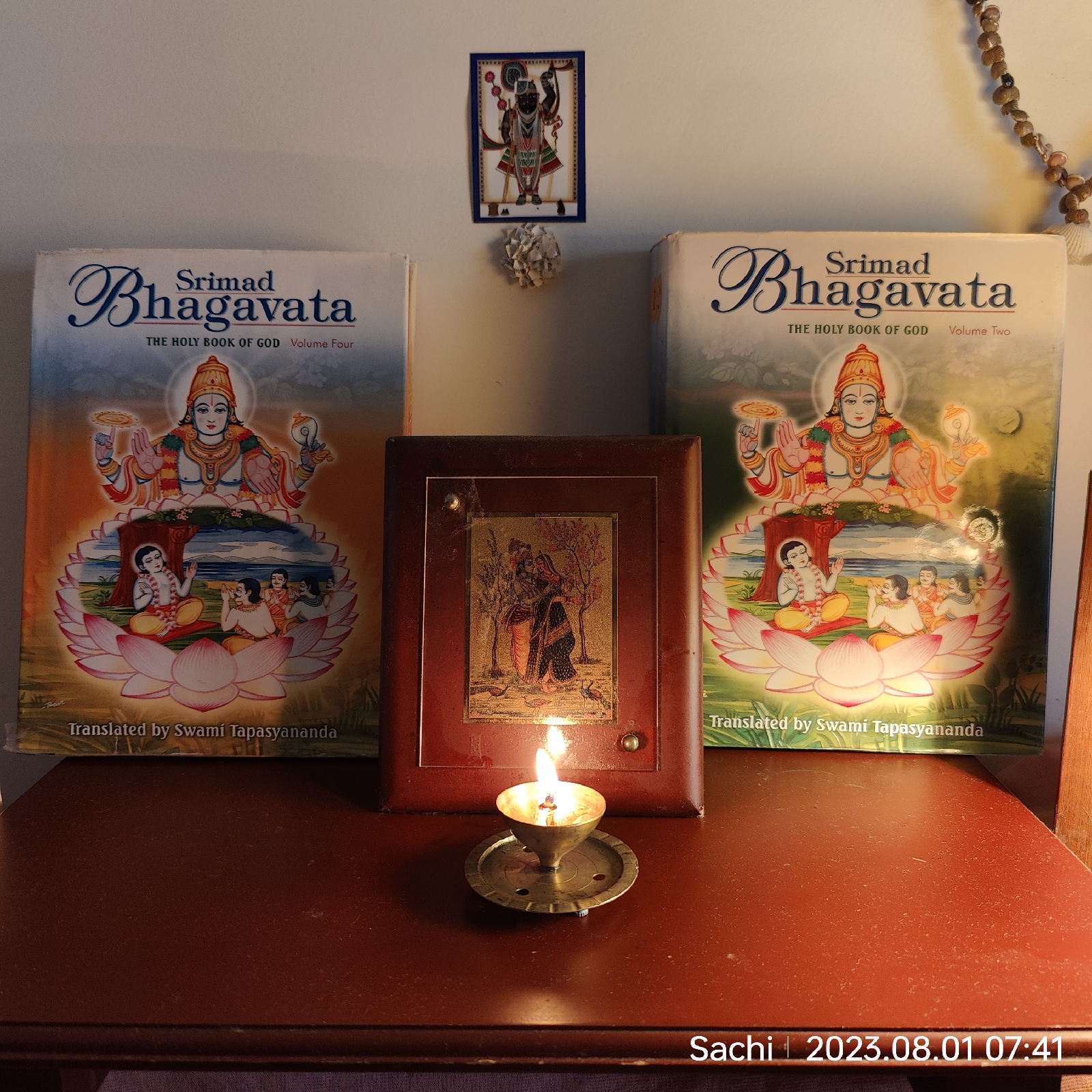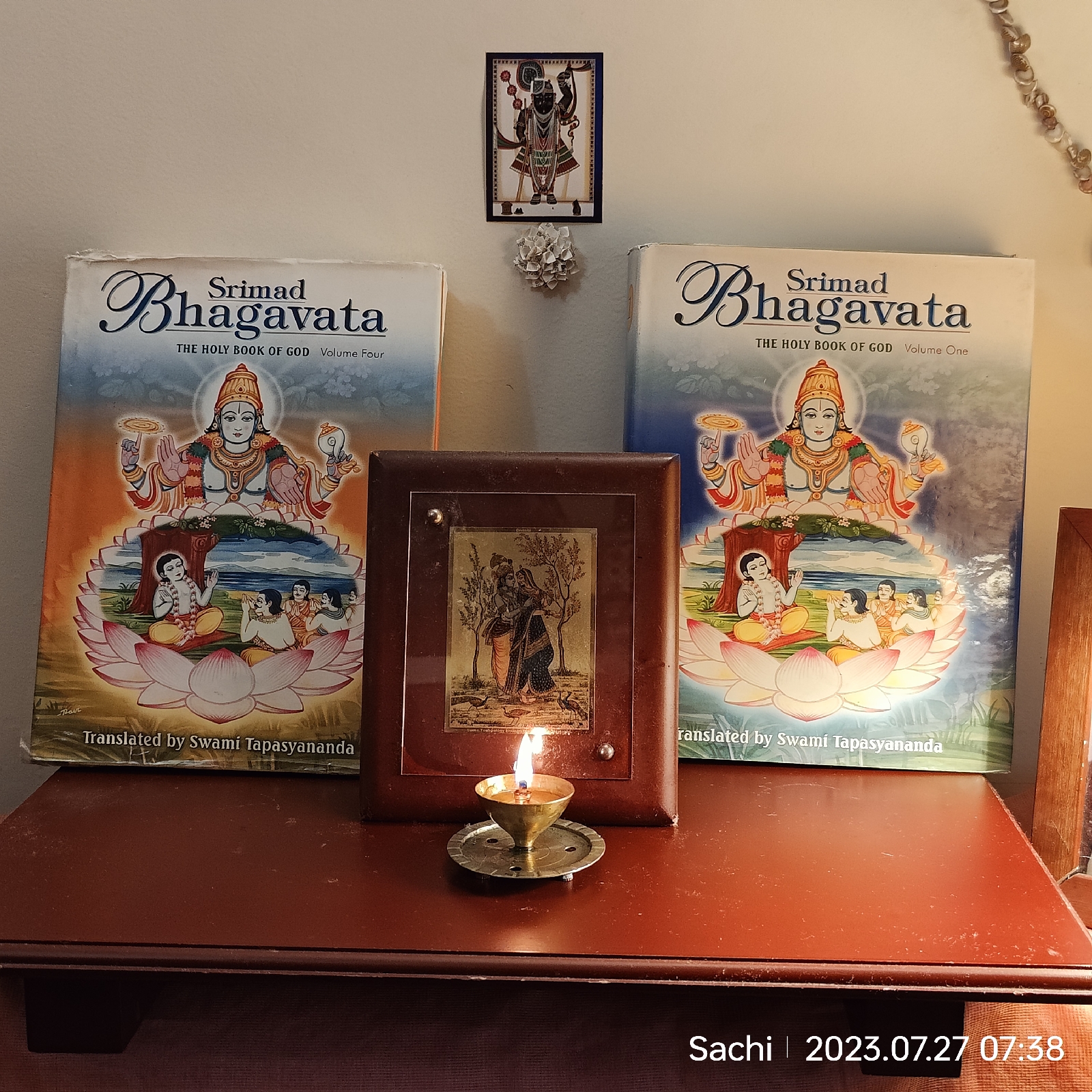॥ ॐ नमो भगवते वासुदेवाय ॥
***
श्रीउद्धव उवाच
क्रियायोगं समाचक्ष्व भवदाराधनं प्रभो ।यस्मात्त्वां ये यथार्चन्ति सात्वता: सात्वतर्षभ ॥
एतद् वदन्ति मुनयो मुहुर्नि:श्रेयसं नृणाम् ।नारदो भगवान् व्यास आचार्योऽङ्गिरस: सुत: ॥
T: Uddhava said: "My dear Lord, Oh master of the devotees, please explain to me the prescribed method of worshipping you in your Deity form (ie Pooja). (This is referred to here as Kriya Yoga.) What are the qualifications of those devotees who worship the Deity, on what basis is such worship established, and what is the specific method of worship? All the great sages repeatedly declare that such worship brings the greatest benefit possible in human life. This is the opinion of Devarshi Narada, the great Vyasa and my own spiritual master, Brihaspati."
नि:सृतं ते मुखाम्भोजाद् यदाह भगवानज: ।पुत्रेभ्यो भृगुमुख्येभ्यो देव्यै च भगवान् भव: ॥
एतद् वै सर्ववर्णानामाश्रमाणां च सम्मतम् ।श्रेयसामुत्तमं मन्ये स्त्रीशूद्राणां च मानद ॥
एतत् कमलपत्राक्ष कर्मबन्धविमोचनम् ।भक्ताय चानुरक्ताय ब्रूहि विश्वेश्वरेश्वर ॥
T: "Bhagavan, the instructions on this process of Deity worship first emanated from Your lotus mouth. Then they were spoken by the great Lord Brahma to his sons, headed by Bhrigu, and by Lord Shiva to his wife, Devi Parvati. This process is accepted as appropriate for all the Varna and Asharma orders of society. Therefore I consider worshipping you, Bhagavan, in your Deity form to be the most beneficial of all spiritual practices for all, men, women, and even lower orders of society. (So no one has been disallowed the right to worship in our scriptures. Only the methods and details may differ).
Oh lotus-eyed Lord of the universe, please explain to this devoted servant of yours the means of liberation, i.e. the path of worship."
श्रीभगवानुवाच
न ह्यन्तोऽनन्तपारस्य कर्मकाण्डस्य चोद्धव ।सङ्क्षिप्तं वर्णयिष्यामि यथावदनुपूर्वश: ॥
वैदिकस्तान्त्रिको मिश्र इति मे त्रिविधो मख: ।त्रयाणामीप्सितेनैव विधिना मां समर्चरेत् ॥
यदा स्वनिगमेनोक्तं द्विजत्वं प्राप्य पूरुष: ।यथा यजेत मां भक्त्या श्रद्धया तन्निबोध मे ॥
T: Bhagavan replied: "My dear Uddhava, there is no end to the innumerable Vedic prescriptions (Karma Kanda) for performing Deity worship; so I shall explain this topic to you briefly, one step at a time. One should carefully worship me by selecting one of the three methods by which I receive Yajna: Vedic, Tantric or mixed. Now please listen faithfully as I explain exactly how a person who has achieved the twice-born status (i.e.one who has received Mantra Diksha) through the relevant Vedic prescriptions should worship me with devotion.
(Note: Twice-born is a term applied to those who receive Mantra initiation. Everyone is born in a human body, but he is born a second time, i.e. awakened spiritually, only when he receives Mantra initiation. The greatest Mantra initiation is called Upanayana when the Gayatri Mantra is taught. Upanayana means an extra pair of eyes, i.e. spiritual insight!)
अर्चायां स्थण्डिलेऽग्नौ वा सूर्ये वाप्सु हृदि द्विज: ।द्रव्येण भक्तियुक्तोऽर्चेत् स्वगुरुं माममायया ॥
T: A twice-born person should worship me, his worshippable Lord, without duplicity, offering appropriate paraphernalia in loving devotion to my Deity form or to a form of mine appearing upon the ground, in fire, in the sun, in water or within the worshipper’s own heart. (Note: so worship can be of images or even elements in nature or even through visualisation in one's heart- Manasa Puja!!)
पूर्वं स्नानं प्रकुर्वीत धौतदन्तोऽङ्गशुद्धये ।उभयैरपि च स्नानं मन्त्रैर्मृद्ग्रहणादिना ॥
T: He should first purify his body by cleansing his teeth and bathing. Then he should perform a second cleansing by smearing the body with sanctified earth and chanting both Vedic and Tantric Mantras.
सन्ध्योपास्त्यादिकर्माणि वेदेनाचोदितानि मे ।पूजां तै: कल्पयेत् सम्यक् सङ्कल्प: कर्मपावनीम् ॥
T: Fixing the mind on me, one should worship me by his various prescribed duties, such as chanting the Gayatri Mantra at the three junctures of the day. Such performances are enjoined by the Vedas and purify the worshipper of reactions to Karma.
शैली दारुमयी लौही लेप्या लेख्या च सैकती ।मनोमयी मणिमयी प्रतिमाष्टविधा स्मृता ॥
T: The Deity form of the Lord is said to appear in eight varieties — stone, wood, metal, earth, paint, sand, the mind or jewels.
चलाचलेति द्विविधा प्रतिष्ठा जीवमन्दिरम् ।उद्वासावाहने न स्त: स्थिरायामुद्धवार्चने ॥
अस्थिरायां विकल्प: स्यात् स्थण्डिले तु भवेद् द्वयम् ।स्नपनं त्वविलेप्यायामन्यत्र परिमार्जनम् ॥
द्रव्यै: प्रसिद्धैर्मद्याग: प्रतिमादिष्वमायिन: ।भक्तस्य च यथालब्धैर्हृदि भावेन चैव हि ॥
T: The Deity form of the Lord, who is the refuge of all living entities, can be established in two ways: temporarily or permanently. But a permanent Deity, having been invoked in an image, can never be sent away. The Deity that is temporarily established can optionally be invoked and dissolved/sent away, but these two rituals should always be performed when the Deity is an image drawn upon the ground. Bathing should be done with water except if the Deity is made of clay, paint or wood, in which case a thorough cleansing without water is enjoined. One should worship me in my Deity forms by offering the most excellent items of worship. But a devotee completely freed from material desire may worship me with whatever he is able to obtain, and may even worship me within his heart with mentally visualised offerings.
स्नानालङ्करणं प्रेष्ठमर्चायामेव तूद्धव ।स्थण्डिले तत्त्वविन्यासो वह्नावाज्यप्लुतं हवि: ॥
सूर्ये चाभ्यर्हणं प्रेष्ठं सलिले सलिलादिभि: ।श्रद्धयोपाहृतं प्रेष्ठं भक्तेन मम वार्यपि ॥
भूर्यप्यभक्तोपाहृतं न मे तोषाय कल्पते ।गन्धो धूप: सुमनसो दीपोऽन्नाद्यं च किं पुन: ॥
T: In worshipping the temple Deity, bathing and decoration are the most pleasing offerings. For the Deity traced on sacred ground, the process of Tattva-vinyasa is most dear. Oblations of sesame and cereal soaked in ghee are the preferred offering to the sacrificial fire, whereas worship consisting of oblation and Arghya is preferred for the sun. One should worship me in the form of water by offering water itself. Actually, whatever is offered to me with faith by my devotee — even if only a little water — is most dear to me. Even very opulent presentations do not satisfy me if they are offered by non-devotees. But I am pleased by any insignificant offering made by my loving devotees, and I am certainly most pleased when fine presentations of fragrant oil, incense, flowers and delectable foods are offered with love.
शुचि: सम्भृतसम्भार: प्राग्दर्भै: कल्पितासन: ।आसीन: प्रागुदग् वार्चेदर्चायां त्वथ सम्मुख: ॥
कृतन्यास: कृतन्यासां मदर्चां पाणिना मृजेत् ।कलशं प्रोक्षणीयं च यथावदुपसाधयेत् ॥
तदद्भिर्देवयजनं द्रव्याण्यात्मानमेव च ।प्रोक्ष्य पात्राणि त्रीण्यद्भिस्तैस्तैर्द्रव्यैश्च साधयेत् ॥
T: After cleansing himself and collecting all the itmes of offering, the worshipper should arrange his own seat with blades of kusha grass whose tips point eastward. He should then sit facing either east or north, or else, if the Deity is fixed in one place, he should sit directly facing the Deity. The devotee should sanctify the various parts of his body by touching them and chanting Mantras. He should do the same for my Deity form, and then with his hands, he should clean the Deity of old flowers and the remnants of previous offerings. He should properly prepare the sacred pot and the vessel containing water for sprinkling. Then, with the water of that sanctified vessel, he should sprinkle the area where the Deity is being worshipped, the offerings that are going to be presented, and his own body. Next, he should decorate with various auspicious substances three vessels filled with water.
पाद्यार्घ्याचमनीयार्थं त्रीणि पात्राणि देशिक: ।हृदा शीर्ष्णाथ शिखया गायत्र्या चाभिमन्त्रयेत् ॥
T: The worshipper should then purify those three vessels. He should sanctify the vessel holding water for washing the Lord’s feet by chanting "Hridayaya Namah", the vessel containing water for Arghya by chanting "Shirase Swaha", and the vessel containing water for washing the Lord’s mouth by chanting 'Shikhayai Vashat". Also, the Gayatri Mantra should be chanted for all three vessels.
पिण्डे वाय्वग्निसंशुद्धे हृत्पद्मस्थां परां मम ।अण्वीं जीवकलां ध्यायेन्नादान्ते सिद्धभाविताम् ॥
T: The worshipper should meditate up Bhagavan's subtle form — which is situated within the worshipper’s own body, now purified by air and fire — as the source of all living entities. This form of the Lord is experienced by self-realized sages in the last part of the vibration of the sacred syllable OM.
***








